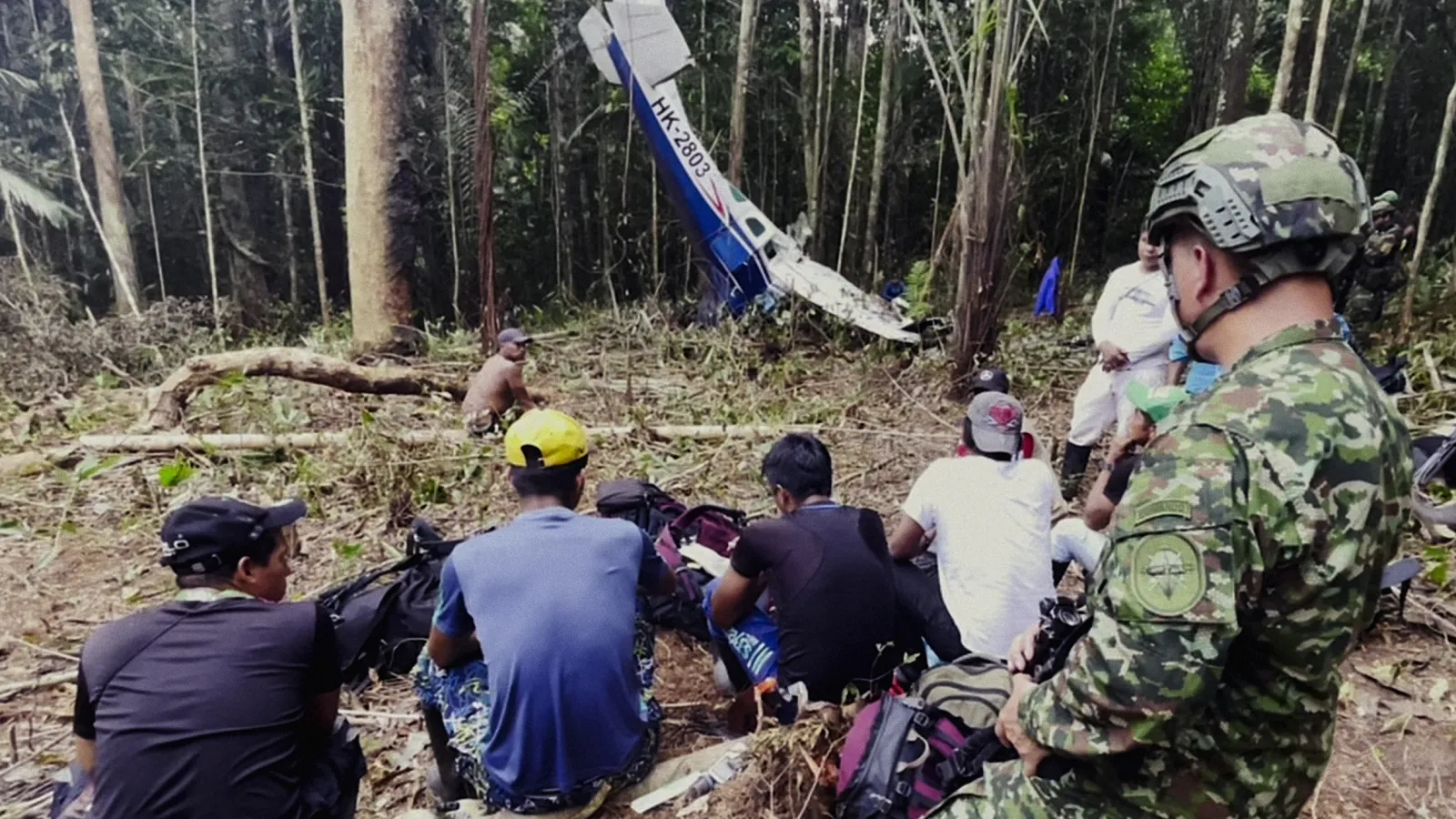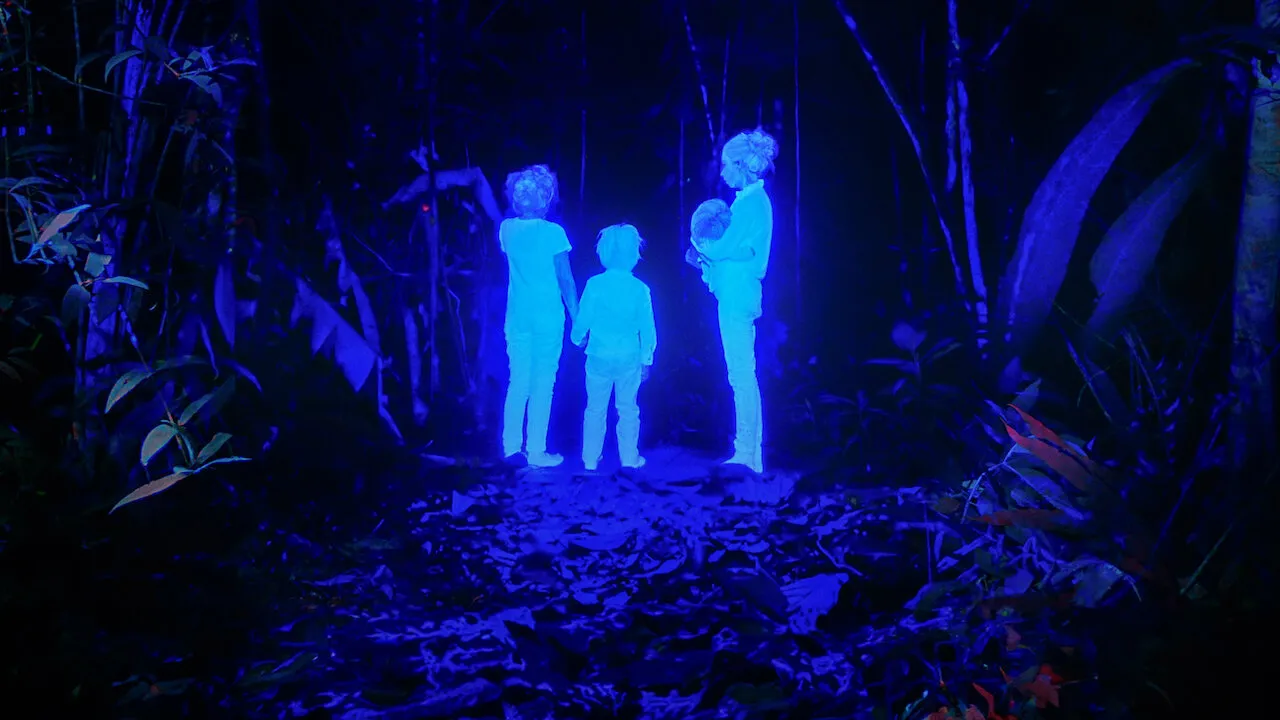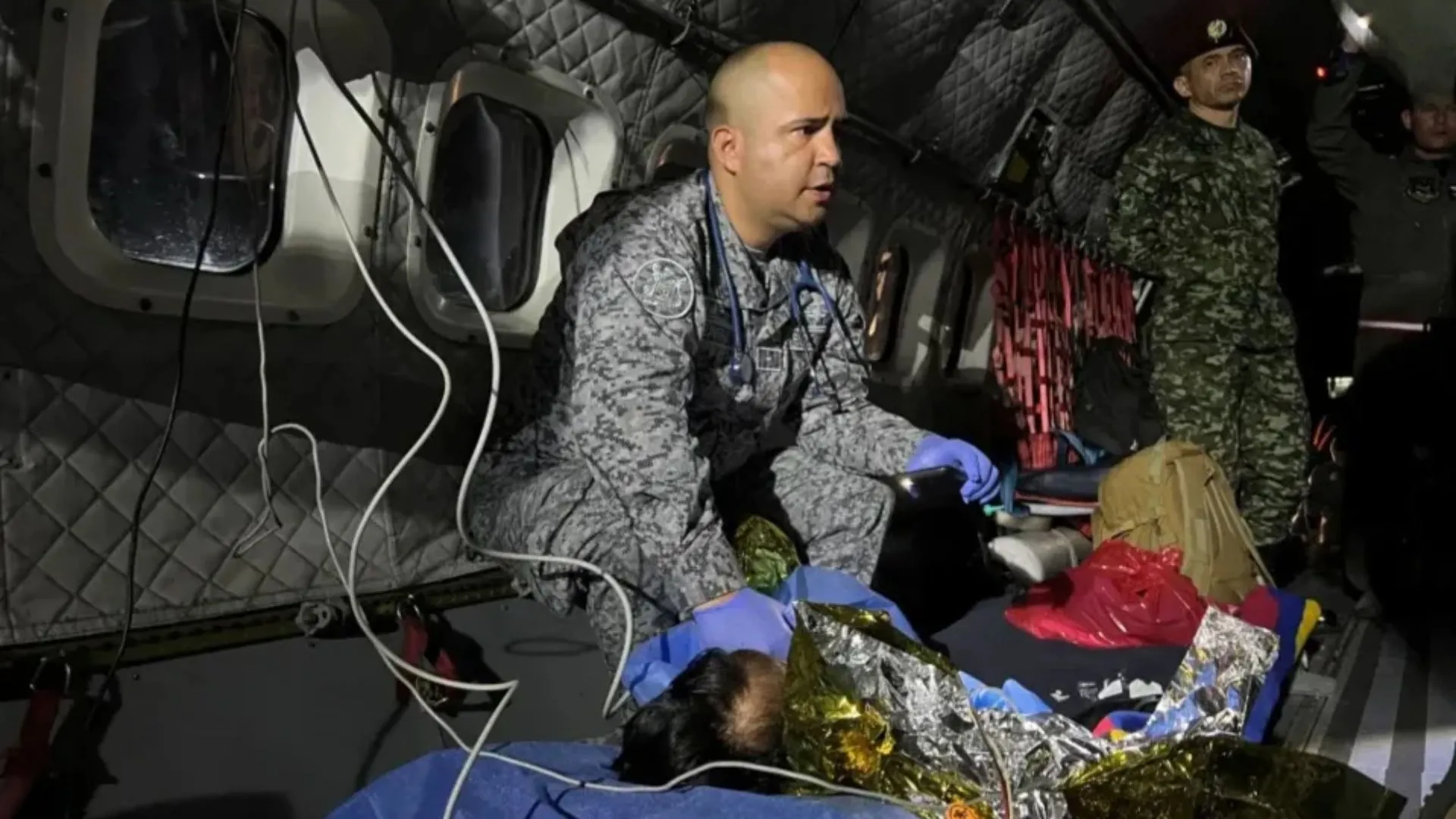The Lost Children, directed by Orlando von Einsiedel, Lali Houghton, and Jorge Durán, transports viewers to the Amazon rainforest of Colombia for a tense narrative. The film tells the story of the search for four Indigenous children: Lesly, Soleiny, Tien Noriel, and a baby named Cristin.
They have to get through a dangerous landscape after a terrible plane crash. Their story is like Hansel and Gretel’s. They leave behind a trail of used diapers and half-eaten fruits, showing that the jungle can be both friendly and dangerous.
Von Einsiedel, who won an Oscar for The White Helmets, gives the storytelling emotional depth. The film shows how complicated the connection between local tribes and state forces is, and it becomes a metaphor for the Indigenous people’s fight against past wrongs. Viewers are forced to consider whether cooperation can emerge from a legacy of mistrust as the military and Indigenous communities work through their tense dynamics.
Ultimately, the documentary is a psychological look at survival—not just of the body but also of culture and identity in a society growing farther away from its roots.
The Heart of the Story: The Children
Lesly, Soleiny, Tien Noriel, and the baby Cristin, the four siblings at the center of The Lost Children, become symbols of resilience and survival after a terrible plane crash. Lesly, the eldest, emerges as a natural leader at thirteen. Her resourcefulness is amazing; she keeps her younger siblings alive while grappling with the weight of responsibility.
The happy 9-year-old, Soleiny, stands in stark contrast to the gravity of their situation, representing innocence amid confusion. Baby Cristin, who is only 11 months old, is the epitome of vulnerability in the wild. Tien Noriel, the playful 4-year-old, adds humor to the dire circumstances.
Their bond with Magdalena Mucutuy, their mother, is full of love and loss. Because she was from the Huitoto tribe, she taught her children a deep connection to their cultural roots. This information becomes crucial as they try to stay safe in the rainforest. The crash takes away their mother and sends them on a dangerous journey that tests their survival skills. In a terrible twist of fate, they lose their anchor when they need her the most.
Such a loss is very hard on the emotions. Children are left to fight for themselves in the immediate aftermath, grappling with grief and learning to trust their guts. Their survival stands as a testament to human resilience at its core. In the face of difficulty, instincts take over, turning fear into resourcefulness, as the film vividly demonstrates. A good question comes up: what does it mean to survive? Is it just existing, or is it about keeping a connection to one’s culture and identity even under the most trying circumstances?
What the siblings went through in the jungle is a microcosm of the problems that Indigenous communities in Colombia face in general. In addition to a physical fight for survival, they are also fighting a cultural war similar to fights against erasure and marginalization in the past. The children’s innocence serves as a symbol of hope, inspiring viewers to reflect on the resilience of those who are frequently forgotten or silenced.
The Search Efforts: Operation Hope
The Lost Children takes us deep into the heart of Colombia’s Amazon, where the search for four lost siblings takes place under the name “Operation Hope.” This operation, a collaboration between the Colombian military and Indigenous volunteers, highlights the fascinating—and at times, contentious—dynamic between technological prowess and traditional knowledge.
At first, the military reaction was typical of modern rescue operations: helicopters and other high-tech equipment were sent into the jungle by force of will, driven by a sense of urgency and maybe a bit of arrogance. They use computerized search grids and megaphones to play words from the mother of the children, pleading with them to stay put. However, as the days go by and there is no progress, the flaws in the system become very clear. In all its wild beauty, the jungle seems to make fun of the high-tech tools that were made to control it.
The narrative of the search is changed by the Indigenous volunteers’ in-depth understanding of the region. The military sees the jungle as a battlefield that needs to be tamed, but the people see it as a living thing full of stories and secrets. Despite being called “primitive” by strangers, their methods show a deep understanding of nature that the military badly needs. The central conflict in the film is this contrast between the cold, calculated logic of technology and the intuitive, spiritual connection to the Earth.
The search attempts are affected by the fact that the military and Indigenous communities have a history of mistrusting each other. The long-running war in Colombia has left its mark; many Indigenous people face repression and violence at the hands of state forces. At first, the two groups don’t talk to each other and are suspicious of each other’s intentions. There is a palpable tension in the humid air because the military’s top-down method doesn’t match up with the Indigenous searchers’ local knowledge.
However, an amazing change occurs as the parents’ desperate search for their children continues. It’s strange how the situation’s urgency leads to a sense of community. The military starts to recognize the Native American soldiers because they know how important their survival skills are. A microcosm of what Colombia could be if old grudges were forgotten, Operation Hope became a powerful symbol of unity due to this gradual change.
The film reflects on the potential for collaboration across cultural divides in this way, serving as more than just a survival story. Who holds the key to survival when the stakes are this high? It makes you wonder about the nature of authority and community. The merging of these two worlds, which is tense but full of hope, provides a potent commentary on the possibilities that can happen when different groups work together for a shared goal. The film makes us wonder if the real miracle is finding the lost children or fixing a broken society.
Themes of Survival and Resilience
The resourcefulness and resilience of the four siblings are central to The Lost Children’s profound study of survival at its core. The eldest, Lesly, emerges as a leader and leads her younger siblings through the dangers of the Amazon.
Her capacity for adaptation—finding food, navigating their environment, and safeguarding her siblings—is a testament to the innate human instinct to survive in the face of overwhelming odds. Lesly seems to embody a primal archetype, a modern-day Mowgli navigating the dangerous wilderness, where every rustle in the thorns could mean danger or chance.
In this narrative, nature is both a dangerous foe and an important ally. The jungle is shown not only as a background but also as a figure in its own right—something that gives life and demands respect. Fear is transformed into a fierce drive as the children’s survival instincts take over. The film does a great job of showing this duality; the lush plants hide dangerous things while also producing tasty foods. “You can’t live with it, you can’t live without it” is a good way to describe it.
The themes of collaboration and unity further enhance the narrative. The merging of military and Indigenous efforts during Operation Hope gives a glimmer of hope for a country that has previously been divided. The film highlights the potential for cooperation in the face of difficulty as the two groups unite. This partnership is a microcosm of Colombian society. It shows that united action can produce good results, even when there are deep-seated conflicts.
This collaboration raises important questions about cultural respect and recognition. While praising Indigenous people’s knowledge, the film subtly criticizes state authority’s paternalistic tendencies. Viewers are asked to consider how important it is for society to be inclusive. The search for the children creates unity, which is a powerful metaphor for what Colombia can do when its different groups work together toward a common goal, putting aside old grudges.
In this way, the film has meaning beyond its immediate narrative and encourages viewers to reflect on the bigger picture of resilience in the face of systemic difficulties.
Cinematic Techniques and Storytelling
The Lost Children uses a lot of different filmmaking styles to make its narrative more than just a documentary. The film’s visual storytelling is especially striking, with nature cinematography that shows how beautiful and dangerous the Amazon jungle is. In each frame, the green plants are both a safe place and a threat, creating a visual contrast that reflects the children’s situation.
The camera stays on the intricate details of the jungle for a long time, focusing on the glowing insect wings, the thick underbrush, and the scary shadows that the tall trees make. This cinematography not only immerses the audience in the environment but also raises the emotional stakes, making every leaf rustle feel like a heartbeat in the wild.
The interaction between reenactments and documentary film further enhances the story. The reenactments dramatically portray the children’s experiences but risk becoming too showy. However, they serve a purpose—they help us understand the children’s fears and feelings more deeply. On the other hand, the documentary footage grounds the narrative in reality, making for a stark contrast that emphasizes the gravity of the situation. This balance is just right, letting viewers move back and forth between the emotional power of dramatization and the sobering weight of real events.
The narrative format of the film depends on sound and music. The score, which is at times ethereal and haunting, conveys urgency and sadness. Along with the drama, it creates an emotional undercurrent that keeps the viewer’s heart rate steady. Soundscapes might be seen as the film’s “invisible hand,” pulling us toward understanding.
Voiceovers and conversations also play a crucial role as narrative anchors. They give the story some background and connect human stories to the bigger picture of the search. The voices of family members and community leaders give the numbers more meaning by turning them into stories and creating a connection to the plight of the children. This method of fusing personal accounts with the main narrative heightens the film’s emotional impact. It serves to remind us that every headline has a human story.
In the end, the film’s cinematic techniques work together to create a narrative that is both interesting and moving, making viewers think about how survival, culture, and the environment interact in a complex way.
Cultural and Social Commentary
The Lost Children is a moving reflection on Indigenous rights and representation while navigating Colombia’s long history of conflict. The documentary doesn’t hide the uncomfortable facts about colonialism and the systemic oppression Indigenous communities face.
Instead, it uses the scary story of the children to examine these problems. As the struggles of Lesly, Soleiny, Tien Noriel, and Cristin become symbols of larger ones, they carry the voices of many who have been silenced in a society that often values modernity over ancestral wisdom.
It is crucial to emphasize Indigenous perspectives. The children’s survival instincts are shown in the film to be rooted in their current circumstances and cultural background. They can survive because of their connection to the land they learned from their mother and the Huitoto community. A sort of “survival kit,” if you will, this connection is more than just symbolic; it is a reclamation of identity in the face of erasure. The narrative changes as the search progresses, allowing Indigenous voices to emerge and challenging the established narratives that frequently exclude these groups.
In addition, the search itself becomes an important moment for national identity. It becomes a place where people from different parts of the country can unite, bridging the gaps between them. The cooperation between military and Indigenous volunteers represents a potential change in how people think about things or even a way to build peace. This changing dynamic brings up questions about the nature of authority and respect. Can the military, which has been seen as an abuser in the past, become a partner for Indigenous communities?
The documentary quietly criticizes how people think about the military, encouraging viewers to question what they think they know. The military’s role changes as the search goes on, from a distant authority to an active participant in the children’s story—a change that shows the potential for historical wound healing. This complex portrayal prompts the audience to reflect on what true unity in a divided country means.
The Lost Children’s multifaceted investigation not only highlights the urgent need for justice and representation but also opens a conversation about the complexities of national identity in modern Colombia.
Legacy and Impact of the Documentary
A moving testament to the resilience of the human spirit, the children’s current situation—now that they are back with their family—remains in the aftermath of the rescue. Even though their health is better, the tragedy they went through is still a shadow over it.
Conversations about Indigenous rights, survival, and the complexities of Colombian identity have been sparked by the extremely positive public response to The Lost Children. The documentary doesn’t just move people; they feel compelled to take action on the bigger problems it brings up.
The film has had a long-lasting effect on people. It becomes a cultural artifact that encourages discussion about the need for greater respect and recognition of Indigenous narratives, going beyond a straightforward account of events. Viewers are left with a sense of hope because they know resilience can appear even in the most dire circumstances.
There is more to this documentary than just a story of survival. It’s a call to see how strong community and tradition can be. Its emotional and cultural depth makes audience members reflect on their narratives and society. The Lost Children is a powerful movie that everyone who wants to learn more about how people keep going should see even when things get hard.
The Review
The Lost Children
A moving look at survival, resilience, and the complicated relationships between Indigenous communities and state authority, The Lost Children is a must-watch. The documentary highlights the terrifying journey of four siblings through its stunning cinematography and powerful storytelling. It also starts larger conversations about cultural unity and identity in Colombia. Its emotional depth and cultural significance make it an important movie because it encourages the audience to reflect on the complexities of hope and community.
PROS
- Powerful storytelling that combines personal and cultural narratives.
- Stunning cinematography that captures the beauty and danger of the Amazon.
- Strong emphasis on Indigenous perspectives and rights.
- Emotional depth that resonates with audiences.
- Encourages dialogue about societal unity and resilience.
CONS
- Some reenactments may feel overly dramatized for certain viewers.
- The pacing can be uneven, with moments of tension followed by slower segments.
- Historical context may require additional knowledge for full appreciation.





















































